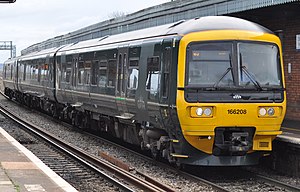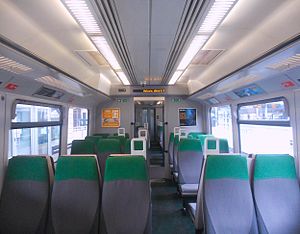British Rail Class 166
| British Rail Class 166 Networker Turbo Express | |
|---|---|
 Great Western Railway 166208 at Didcot Parkway in 2015 | |
 The refurbished interior of Standard Class | |
| In service | 1992 - Present |
| Manufacturer | ABB York |
| Family name | Networker |
| Constructed | 1992 - 1993 |
| Number built | 21 trainsets |
| Formation | 3 cars per trainset |
| Fleet numbers | 166201 - 166221 |
| Operator(s) | Great Western Railway |
| Depot(s) | St Philips Marsh HSTD |
| Line(s) served |
|
| Specifications | |
| Car body construction | Welded aluminium |
| Maximum speed | 90 mph (145 km/h) |
| Prime mover(s) | One per car, Perkins 2006-TWH Diesel |
| Power output | 350 hp (261 kW) |
| Transmission | Voith Hydraulic T211r 2 axles driven per car |
| Safety system(s) | AWS, TPWS |
| Coupling system | BSI[1] |
| Track gauge | 1,435 mm (4 ft 8 1⁄2 in) standard gauge |
The British Rail Class 166 Turbo Express is a fleet of diesel multiple units (DMUs), originally specified by and built for British Rail, the then United Kingdom state owned railway operator. They were built by ABB at York Works between 1992 and 1993.[2] The trains were designed as a faster, air conditioned variant of the Class 165 Turbo, intended for longer distance services, and, like the 165s, belong to the Networker family of trains. They were originally known as Networker Turbos to distinguish them from the electrically propelled members of that family. Today, the 166's alongside the 165's are normally referred to as Thames Turbos or just simply Turbos.
The Class 166s are still in service today and are used for express services out of London Paddington and local services out of Reading and Didcot Parkway alongside the Class 165s. In July 2017, they began operation on the Severn Beach line in Bristol to allow other services to be strengthened. Since September, they have rapidly been introduced on other services such as the Weston-super-Mare to Bristol Parkway service and the Cardiff Central to Taunton services. In January 2018, they began service on the Golden Valley Line and in February 2018, they began service on the Heart of Wessex Line. They also have begun to operate some services on the Wessex Main Line as far as Warminster and Southampton Central. As of March 2018, most of the 166 family have moved to Bristol and are now based at St Philip's Marsh.
Contents
1 Description
2 Operations
3 London and Thames Valley Refresh
4 Fleet details
5 Liveries and interiors
6 References
Description
These units are a modification of the Class 165 design. They have a top speed of 90 mph (145 km/h) (suitable for mainline use), are carpeted throughout and have air-conditioning. Externally, the class 166 can be distinguished from a Class 165 by opening hoppers on every other window. Until late 2013 the presence of first class at each end was another distinguishing feature.
Other differences over a 165 are as follows:
- Air conditioning
- Two toilets (a 165 only has one toilet per unit)
- Tables in first class and in one third of the middle carriage
- Dedicated cycle/luggage storage in the middle carriage
- Different interior panelling between the door and seating areas
Twenty-one 3-car units were built, numbered 166201-221. Each unit was formed of two outer driving motors, and an intermediate motor. The technical description of the formation is DMCO+MSO+DMSL. Individual carriages are numbered as follows:
- 58101-58121 - DMCO
- 58601-58621 - MSO
- 58122-58142 - DMSL changed from DMCO in 2013[3]
The units were built to replace elderly Class 117, Class 119 and Class 121 DMUs, and locomotive-hauled trains on services from London Paddington along the Great Western Main Line.
Six cars were added to the original order in 1991 after Network SouthEast acquired some of the Cotswold Line services from Regional Railways to allow Class 158 units to be converted to Class 159s for the West of England services.[4][5]
Class 166 units are designed for driver-only operation. In cases where a Guard is required they must carry out their door operation duties via a bell system to signal the Drivers to close doors and start the train. This requires the Guard to return to a vacant cab at each station to carry out these duties; this practice can be observed on Great Western Railway services on the Cotswold Line and North Downs Line.[citation needed]
Their operation in the Bristol area is slightly different. All services in the Bristol area have guards and will in the future so the trains will not be driver only operated at all in the Bristol area. The practice of the opening/closing of the doors is also different, in which the driver releases the doors which are then closed by the guard. All 166 units now have local door panels fitted in at the doors of the end coaches, this is to allow the units to stop at stations with short platforms such as Avoncliff, Dilton Marsh and Stonehouse. In these instances, the guard releases only his local door with these new panels, so drivers do not release the doors at the stations with short platforms.
Operations

166220 arrives at Oxford with a service to London Paddington.
When built, these units were operated by the Thames Line and North Downs Line subdivisions of Network SouthEast.
Their main destinations included fast-trains to Reading, Newbury and Oxford, with some services continuing beyond Oxford to Banbury and Stratford-upon-Avon, or along the Cotswold Line to Evesham, Worcester, Great Malvern and Hereford. Units are also used on the Reading to Gatwick Airport services along the North Downs Line. Many services operated by the 166 were branded as Turbo Express in the timetables.
Following privatisation, the units passed to the Thames Trains franchise. In April 2004, operation of the Thames Trains franchise passed to the First Great Western Link, and subsequently to First Great Western.
In 2012, First Great Western took delivery of five Class 180 Adelante units for Cotswold Line services, and three-car Class 150 Sprinter units for Reading to Basingstoke Line services, allowing Class 165 and 166 units to be used entirely for Thames Valley services.[6]

Great Western Railway unit 166212 at Clifton Down on the Severn Beach Line in Bristol, July 2017
From July 2017, a number of Turbos were transferred to Bristol for services on the Severn Beach Line to provide extra capacity during busy services.[7] From October 2017, the 166s began on Weston-super-Mare to Bristol Parkway and Cardiff Central to Taunton services. As more of the 166s moved to Bristol, they also started service on the Heart of Wessex Line and Golden Valley line in 2018, replacing Class 150 units on these lines.
London and Thames Valley Refresh

166217 in Thames Trains livery with First Great Western Link branding.
Towards the end of January 2010, First Great Western announced an £8 million refresh programme to their fleet of Class 166 Turbo DMU trains.[8]
The carpets & seats were retrimmed, interiors repainted, Passenger Information Displays replaced with a GPS based system and toilets upgraded. The refresh work was carried out at Reading Depot. All 151 vehicles have now been refurbished.
In late 2014, another set of refreshes to the Class 166 was started. This included the fitting of LED head/tail lights, new toilets which are more accessible than the old toilets, new door buzzers & new door buttons of the standard design with a round button on a yellow ring. All units have now received the refresh. Unit 166204 was named in honour of Twyford station master Norman Topsom MBE who retired in November 2015. The changes made during the 2010 refresh remain in place, however the units will all be receiving new 2+2 seating, for use on longer distance services such as Bristol to Weymouth once the fleet are cascaded to the Bristol area.
Fleet details
| Class | Operator | No. Built | Year Built | Cars per Set | Unit nos. |
|---|---|---|---|---|---|
Class 166/2 | Great Western Railway | 21 | 1992–1993 | 3 | 166201 - 166221 |
Liveries and interiors

The refurbished interior of First Class cabin aboard GWR Class 166 166205

First Great Western Class 166 No. 166201 at Moreton in Marsh
The interior of First Class cabin of First Great Western Class 166
The interior of Standard Class accommodation of First Great Western Class 166

The refreshed interior of First Class cabin aboard a First Great Western Class 166

The refreshed interior of Standard Class accommodation aboard a First Great Western Class 166

First Great Western Dynamic Lines livery (166207, 2008)
Great Western Railway refurbished green livery (166214, 2016)
![]()
References
^ "Mechanical And Electrical Coupling Index". Rail Safety and Standards Board. Archived from the original on 21 December 2013. Retrieved 20 December 2010..mw-parser-output cite.citationfont-style:inherit.mw-parser-output .citation qquotes:"""""""'""'".mw-parser-output .citation .cs1-lock-free abackground:url("//upload.wikimedia.org/wikipedia/commons/thumb/6/65/Lock-green.svg/9px-Lock-green.svg.png")no-repeat;background-position:right .1em center.mw-parser-output .citation .cs1-lock-limited a,.mw-parser-output .citation .cs1-lock-registration abackground:url("//upload.wikimedia.org/wikipedia/commons/thumb/d/d6/Lock-gray-alt-2.svg/9px-Lock-gray-alt-2.svg.png")no-repeat;background-position:right .1em center.mw-parser-output .citation .cs1-lock-subscription abackground:url("//upload.wikimedia.org/wikipedia/commons/thumb/a/aa/Lock-red-alt-2.svg/9px-Lock-red-alt-2.svg.png")no-repeat;background-position:right .1em center.mw-parser-output .cs1-subscription,.mw-parser-output .cs1-registrationcolor:#555.mw-parser-output .cs1-subscription span,.mw-parser-output .cs1-registration spanborder-bottom:1px dotted;cursor:help.mw-parser-output .cs1-ws-icon abackground:url("//upload.wikimedia.org/wikipedia/commons/thumb/4/4c/Wikisource-logo.svg/12px-Wikisource-logo.svg.png")no-repeat;background-position:right .1em center.mw-parser-output code.cs1-codecolor:inherit;background:inherit;border:inherit;padding:inherit.mw-parser-output .cs1-hidden-errordisplay:none;font-size:100%.mw-parser-output .cs1-visible-errorfont-size:100%.mw-parser-output .cs1-maintdisplay:none;color:#33aa33;margin-left:0.3em.mw-parser-output .cs1-subscription,.mw-parser-output .cs1-registration,.mw-parser-output .cs1-formatfont-size:95%.mw-parser-output .cs1-kern-left,.mw-parser-output .cs1-kern-wl-leftpadding-left:0.2em.mw-parser-output .cs1-kern-right,.mw-parser-output .cs1-kern-wl-rightpadding-right:0.2em
^ "First Great Western Info". Archived from the original on 9 December 2012.
^ "Passengers to benefit from additional carriages" (Press release). First Great Western. 23 February 2015. Archived from the original on 25 March 2015. Retrieved 3 April 2015.
^ "Turbo-trains". Hansard. 192: 278W. 6 June 1991. Retrieved 9 June 2011.
^ "Class 159". Southern E-Group. Retrieved 9 June 2011.
^ "Return of Adelantes to First Great Western confirmed". Railnews.co.uk. Retrieved 23 November 2011.
^ "train maintenance". Great Western Railway. Retrieved 9 June 2017.
^ "Train operator gives Thames Valley Trains an £8million makeover" (Press release). First Great Western. 25 January 2010. Archived from the original on 11 June 2011. Retrieved 9 June 2011.
| Wikimedia Commons has media related to British Rail Class 166. |








